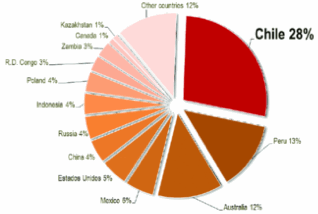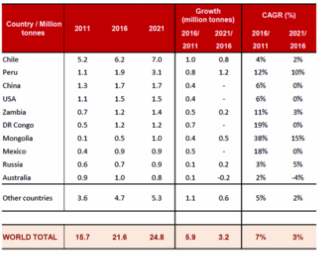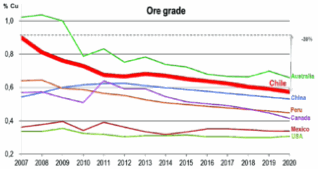Prices will hold steady while grades decline and China will remain the most important customer—those were the key conclusions for the 12th World Copper Conference
By Oscar Martinez, Latin American Editor
Chilean Minister of Mining Hernán de Solminihac opened the 12th World Copper Conference organized by CRU in Santiago de Chile, during April. He explained the forecast extending to 2024 indicates that China will consume more than 50% of the world’s copper production. “We also see the copper mining and processing business becoming more competitive with decreasing ore grades,” de Solminihac said. With that in mind, Chile has created an agency to encourage foreign investment, and it is developing new pro-investment initiatives and policies, along with a national strategy aimed to face current and future energy challenges.
 |
| Source: USGS 2012 World copper reserves, 2011. |
Chile owns Codelco, which is the largest copper miner in the world. Codelco has seen its costs increase by 57% in 2012 and expects costs to continue to rise another 36% in 2013. Codelco CEO Thomas Keller believes copper, as a commodity, has been experiencing quite stable behavior in price terms when compared with other commodities. According to Keller, between 2000 and 2013, relative copper prices increased more than other main nonferrous base metals and energy commodities. “The investment projected for this year has been revised due to various factors such as an increase in the capital expenses of different mining projects,” Keller said. “The reasons for this capex increase are based on deeper deposits with lower grades and increasing ore hardness, remote locations and lack of infrastructure, increasing environmental demands, and difficulties with communities.”
Keller also explained that Codelco is currently facing a number of challenges, such as the decreasing availability of skilled labor in an economy at full employment and the need for new breakthrough technology in their mining and processing operations. However, the company keeps growing and developing new mining projects such as the Ministro Hales mine, Radomiro Tomic Phase II, the New Mine Level at El Teniente, Chuquicamata Underground and the expansion of its Andina mine.
Higher capex is not just a Chilean problem. Most copper miners are dealing with a similar situation. This trend of higher capex indexes was addressed by Jean-Sebastian Jacques, chief executive-copper for Rio Tinto, who also said that his company is focusing on large, long-life prospects, citing the Oyu Tolgoi mine in Mongolia as an example. Rio Tinto believes the growth in emerging markets will create an additional 11 million metric tons per year (mt/y) of demand by 2014.
Diego Hernandez, CEO of Antofagasta Minerals (and former Codelco CEO), explained the company’s growing strategy, indicating that their priority mining project at this time is in the area of the Centinela district, located in northern Chile. At the same time, Antofagasta is working on a pre-feasibility study for an expansion at its Los Pelambres property.
According to Hernandez, Chile has a big opportunity to benefit from continued strong demand for copper, and it will continue to be the biggest copper producer, at least during the next 10 to 20 years. “We—Chile—have the potential of still being the No. 1 copper producer for a long time,” he said.
The Global Market Situation
Copper stocks have been rising, while prices have fallen and the growth in world mine production picked up strongly in 2012. “Copper prices have been very stable over the last few years, a range between $7,300/mt to $8,600/mt,” said Vanessa Davidson, analyst, CRU. “Recently, the prices have reached the low part of that range. CRU strongly believes that copper demand has started to improve, and that the increase in mine production in 2012 is not just a reflection of output from new projects.”
 |
| Source: Codelco. Projection of world copper mine production by country. Note: Projections do not include potential projects or disruptions allowances. |
However, CRU also feels there are still considerable challenges to bringing new supply to the market, and this, along with current upward capex revisions, would be responsible for continued new project delays. According to Davidson, CRU still sees Chile as a competitive country for the short and intermediate terms, but the situation might change in the long run (after 2030).
Echoing those sentiments, Michael Harris, general manager of economics and markets for Rio Tinto, believes China still has plenty of room to run. “Further urbanization will encourage copper demand,” Harris said. “In fact, the country has set a goal of 65% urbanization rate by 2050. The long-term demand outlook remains attractive amid increasing constraints on supply.”
Making a differentiation between China and India, Harris explained that industrial activity has played a major role in China’s growth, while India is more focused on services. Although India is also considered a major copper consumer due to a similar growing need for power generation to support urbanization, investment in overall infrastructure has only been about half of that for China. “We expect copper demand to continue to be steady,” Harris said. “The long-term demand outlook remains attractive.”
Influenced by years of steady investment, metal fundamentals have softened somewhat and copper miners are now focusing on adding value rather than tons. “This has been very visible on the copper market, and from the supply side. We strongly believe the copper market will be better supplied in 2014 and 2015,” said Michael Widmer, head metals strategist, Bank of America Merrill Lynch. “We also believe that there will be a risk of moving into surplus in those years.”
Chinese construction in terms of housing growth is expected to remain solid in 2013. “It is important to emphasize that this growth means ‘completions,’ not ‘new starts’ this year,” said Max Layton, executive director, Goldman Sachs International. “As far as housing in the United States, one of the major ex-China construction-related copper consumers, a structural recovery in residential construction is under way and expected to continue.” Long term, Layton believes the next two to three years should set the market up for the next bull market beyond 2015.
Chilean Minister of Finance Felipe Larrain referred to the situation with the developed economies as a sort of “quantitative relaxing.” “This policy coming from the developed countries is affecting the developing countries—including Chile,” Larrain said. “Countries like Brazil and Argentina are also suffering a slowdown in terms of economic development. Although Chile is clearly a major player in copper supply, the higher costs and the lower production rates seen at Codelco are a big concern for the Chilean Government.”
Javier Targhetta, senior vice president, marketing and sales, Freeport McMoran Copper & Gold, presented a very optimistic forecast. He anticipates positive long-term copper fundamentals, with China remaining an important demand driver and still a major player in world demand. Freeport expects copper demand to grow around 3.2% annually to 2025 thanks to strong economic growth in emerging economies and an anticipated recovery in the developed world.
“An example of it is the healthy automotive sector and the current housing recovery process taking place in the United States,” Targhetta said.
As for the decreasing ore grades reported by copper producers from all over the world, Targhetta explained that the lower ore grades mean an increase in smelting costs because it is required to use more resources to treat the same amount of material and obtain the same output.
Declining ore grades is a factor that Polish copper miner KGHM knows all too well. The company is the eighth largest global copper miner with operations in Poland, Canada, the United States, Chile, Germany and Greenland, and one of the top five Polish companies by revenue—first by net profit.
“Higher production, labor and energy costs, along with a deficiency of significant low-cost copper deposits in Poland and a decline in average copper contents in domestic deposits are some of our main challenges,” said KGHM CEO Herbert Wirth.
 |
| Source: CRU Strategies. Average ore grades continue to decline worldwide. |
A high degree of flexibility and innovation is the approach KGHM plans to take to mitigate the situation. The company’s Sierra Gorda project, an open-pit copper-moly-gold operation in the Antofagasta region of Chile, is currently under construction.
Professor John Tilton, from the Colorado School of Mines, offered some perspective on the impact of cyclical factors on productivity and costs. He said many copper mining regions have recently experienced lower productivity. According to Tilton, this falling productivity is cyclical. “In the 1990s, productivity was dramatically higher and prices were lower,” Tilton said. “After 2003, the situation reversed, with lower productivity and higher prices. When prices rise, productivity falls and vice versa.”
For Chile, in particular, the implications of a lack of energy and water for mine production will also determine the industry’s success moving forward. The country owns two power grid systems—SINC (Central Interconnected System) and SING (Large North Interconnected System)—to satisfy the growing demand for electricity, including mining. Both are expected to grow at moderate rates within the next 10 years.
“Because of the increase in mining operations, we expect a significant growth in energy consumption,” said Erick Heimlich, consultant-copper, CRU. “Competitiveness is not only about prices, but also about availability in Latin America. Important greenfield projects like Panamá in Panama and Mirador in Ecuador, mine owners will have to construct their power delivery system.”
In North America, even in well-established mining districts located in remote areas, power infrastructure may be required for greenfield projects. In Africa, poor power infrastructure is an important obstacle to the mining industry, while Asia has copper producing regions that are also facing deficits in infrastructure: Oyu Tolgoi in Mongolia, for example, is connected to the Chinese power grid for the first four years of operation. After that, a coal-fired power plant will be constructed.
Human Resources
A panel discussion about advanced mining and human capital included top executives from Codelco, Finning and Komatsu, reporting their most recent approaches to achieve improved efficiency through innovation, the use of autonomous mining equipment, and optimization of human resources. Fidel Báez, Codelco’s corporate manager underground mine projects, talked about the main challenges of mass mining and said Codelco’s new underground mining system enables a continuous flow of ore from the mine to the plant. “Technology is key,” Báez said.
Komatsu Chile General Manager Darko Louit Nevistic said copper mining productivity in Chile is declining due to factors such as declining ore grades, longer hauling distances, more remote locations, shortage of qualified personnel, etc.
The company aims to improve productivity by focusing on enhancing labor, capital and operating assets.
Labor costs are growing faster than productivity. “A comprehensive people strategy is as necessary as technology and innovation,” said Juan Antonio Winter, vice president mining–Finning, South America.
There are challenges and opportunities in copper supply and demand. From 2030, demand from China should begin to drop and demand from developing countries will start to ramp-up. Independent consultant David Coombs said in recent years the mining world has seen a significant cash cost and capital cost escalation. A continuation in the trend of rising copper prices is expected, while Sean I. Waller, president and director of Candente Copper Corp., said supply is not sufficient to meet a sustained increase in demand.
For Viviane Lloyd, CRU’s copper demand and markets manager, 2012 was a year when copper consumers began to wonder whether they could use aluminum when the copper price reached $4/lb. CRU believes the aluminum:copper price ratio peaked in 2012. The question is: Has sufficient new technology been developed to displace some copper demand?






